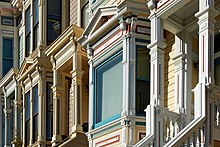Victorian architecture


The name Victorian architecture comes from the Anglophone countries and describes as an overarching name the predominant architectural styles in the Victorian era , i.e. the long reign of the British Queen Victoria from 1837 to 1901 . This trend in architectural history emerged as historicism on mainland Europe .
This designation includes:
- Romantic period (1820-1880)
- Neoclassicism, compare classicism
- Neo-Gothic
- Italianate style
- In the narrower sense (1860-1900)
- Second Empire
- Stick style
- Queen Anne Style
- Shingle style
- Richardsonian Romanesque , Romanesque Revival (includes the Richardsonian Revival)
- Folk Victorian
- Others
- Neo-Grec
- Renaissance Revival , compare Neo-Renaissance
- Jacobethan architecture (forerunner of the Queen Anne Style)
- Scottish Baronial
- the British Arts and Crafts movement
- Painted ladies

A distinction is made between different styles of Victorian architecture on the west coast of the USA. The oldest buildings in San Francisco on Telegraph Hill from 1850 belong to the Carpenter Gothic style, while Victorian houses in "Italianate-style" and "Stick-style" are often found in various cities on the west coast.
The architectural style also characterizes large parts of the east coast of the USA. The city of Louisville , Kentucky has the largest inventory of Victorian mansions outside of England . The architectural style was also used in the former British colonies. In Mumbai (formerly: Bombay ), Victorian ensembles of buildings in the inner city were included in the UNESCO World Heritage List .
See also
Individual evidence
- ↑ Cf. Rank Richards: Historic San Francisco, pp. 250ff.
